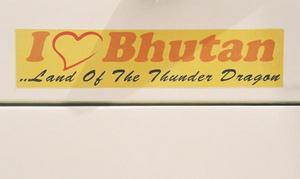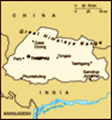Advertisement
Published: October 30th 2006

 ...and who doesn't?
...and who doesn't?
Bus, Trumshing La mountain passLast year's succesful trip to Bhutan not only convinced me that I really wanted to spend more time in this country, but the knowledge that I had only scratched a little bit on its surface pestered me to no end. I kept coming back to my thumbed copy of the first edition of the Lonely Planet guide. Right there, on page 193, in glorious full colour is a half-page photograph of the fortress in Gasa province (it seems to have been omitted in the later editions). Thrown into a sea of thick green forest resting beneath some very evil looking, snow coated, pointy and rugged mountains scraping at the deep blue sky is a tiny yet bright white speck of light, and of hope. Of all the places in Bhutan, none has captured my imagination more than Gasa dzongkhag, a province to the very north of the country, and as such, it was the first to go down on my "have to" list.
Next in line was Punakha, the winter capital, situated in a lush and charming valley, its skyline dominated by one of the most spectacular of the nation's dzongs, a powerhouses of religion and military might combined. The

 Introducing: Tshering
Introducing: Tshering
Profession: Guide
Little known talent: Acting
Favourite food: Riceword 'dzong' has its roots in Tibetan and translates roughly to 'fortress'. They were first introduced as military structures in the 12th century, although the coming centuries would see larger and improved buildings with multiple purposes. Typically perched on hills of strategic importance overlooking their respective valleys they were the focal points for controlling a region, be it keeping tabs on your neighbour or fending off attacks from Tibet. Today the dzongs are no longer controlled by military (except the dzong in Ha province, serving as a base for Indian forces) but instead house regional administrative officials, a court of law as well as one or more temples and a related monk body. There are no blueprints for the dzongs, their architects used their imagination and visions to create these monsters of mud and wood. Using nails was not an option.
So, there you have it, the focus of the trip. Spotting and taking pictures of the often stunning architectural achievements that are a string of odd and highly unique looking buildings, neatly located in photogenic places. This would also serve well as an excuse to travel around the countryside to see more of the nation and its people.

 Introducing: Dorji
Introducing: Dorji
Profession: Driver
Little known talent: Cooking
Favourite food: Ema Datsi (Chili-cheese)Perhaps travelling around the countryside is a bit misleading. Save for a few places in the south there really is no countryside; instead there are terraces and slopes on the many impressive mountains that form Bhutan, or as it is known in the dzongkha language - Druk Yul, literally the valley of the dragon. At its heart, Bhutan is a string of interconnected valleys, and travelling the country is essentially done by following a single main road from the west to the east, detouring as necessary, as it slithers its way around the mountainsides, hugging the rivers.
I started the detail planning of the trip sometime in the early spring. My scruffy copy of the Lonely Planet was my constant companion on the bus to and from work pretty much every day for months. My first plan laid out the towns Wangdue Phodrang, Punakha and Gasa, but since the dzong in Trongsa is one of the most famous I decided to add another day of travelling eastwards to cover it as well. I looked at my map over and over agin, then decided I should also add Jakar, the next city to the east, deep in the cultural heartland

 Introducing: Mr. Rehn
Introducing: Mr. Rehn
Profession: Explorer
Little known talent: Rambling
Favourite food: Alu Dham (Indian potato dish)of the legendary Bhumtang region (the Choskhor Valley). I was now looking at a little bit more than a week's trip. The road continues eastward from Jakar to Mongar, but by this time the distance between the cities increased to seven hours, and the city really isn't considered to be a tourist destination. It it took maybe a week for me to come to the conclusion that I wanted to add Mongar as well. I was now looking at a ten day trip or so. So I did the only sensible thing at this point: no more beating about the bush, I added Trashigang, Trashiyangtse and Lhuentse, the remaining cities in the east as well.
With some additional detours to interesting places en route the trip had grown into a two week project, and due to the nature of travelling in Bhutan, the costs had doubled. All travel in Bhutan is strictly controlled by government policy, dictating that a foreign national must enlist a local travel agency to basically escort and oversee the visitors during his or her entire stay. The travel agency is responsible for arranging accommodation, meals, a guide and means of transportation; the tourist pays a

 Strategic Overview
Strategic Overview
Main destinations of the tripset fee of 200 USD per person and day. This rate is normally not negotiable. If you travel in groups less than four travellers, the cost increases, leaving a single traveller with a surcharge of an additional 40 USD per day.
I was well aware of these obstacles since last year's visit, and this time me and my guide had decided to cut the middle men by excluding the services of any other travel agents. Last year saw the inclusion of a travel agent in Sweden who worked with an agent in Bangkok who worked with the agent in Bhutan, this time we had a direct communication. It was not really a complicated procedure, but it required an enormous amount of patience. Sometimes the telephone network collapsed leaving me out of touch with my friend for days, and when I went to my local bank with the payment instructions for the trip, using a middleman bank on Wall Street, the clerk just looked at me with an expression devoid of even the most basic understanding. In the end we had pulled through with all the preparations, it had taken almost half a year from my first preliminary sketch to the day I finally held a detailed itinerary with a company logotype on top, but that was a very special moment of pride.
The complications of the trip of course were not overcome at this stage; but the stage was set for the greatest adventure. On September 29th I boarded the plane in my hometown Jonkoping. the flight would take me to Stockholm, from there I'd continue to Helsinki and Bangkok. Once I reached Bangkok on the next day, a Saturday I was to pick up my visa and onward plane tickets at my hotel in Bangkok. The flight to Paro, Bhutan, was scheduled on the coming Monday. What could possibly go wrong?
Advertisement
Tot: 0.333s; Tpl: 0.013s; cc: 30; qc: 152; dbt: 0.2345s; 1; m:domysql w:travelblog (10.17.0.13); sld: 1;
; mem: 1.5mb








karma chodon
non-member comment
druk Thongdrel Adventures
mr. john, The journal was nice and inspiring for all the tour operators like us to strive for better facelities, to those individuals wishing to come to Bhutan.